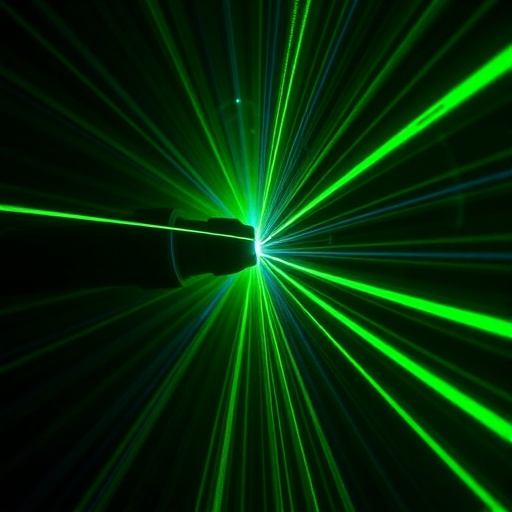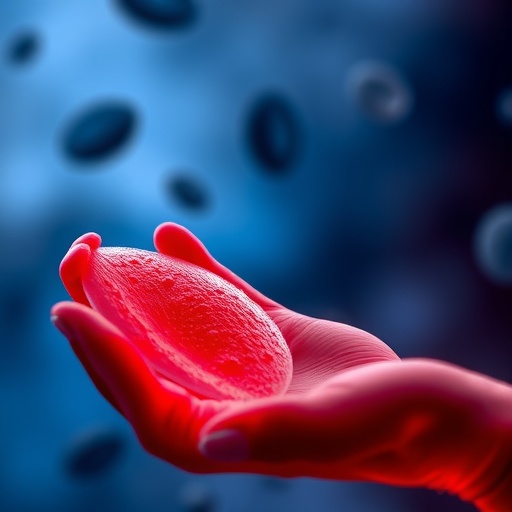In a groundbreaking advance that pushes the boundaries of molecular spectroscopy and fundamental physics, researchers have achieved unprecedented precision in the rovibrational spectroscopy of the simplest homonuclear molecular ion, the hydrogen molecular ion (mathrm{H}_2^+). This accomplishment not only ushers (mathrm{H}_2^+) into the realm of determining fundamental constants with extraordinary precision but also marks a milestone in testing the very fabric of quantum electrodynamics (QED) theories linked to molecular ions.
The central achievement of this study is the spectroscopic determination of the proton–electron mass ratio, a cornerstone physical constant that has long captivated physicists due to its fundamental role in atomic structure and particle interactions. What is striking is that the newly reported value aligns well with previous determinations — including those derived from the electron (g)-factor in hydrogen-like carbon ions — but boasts more than twice the accuracy. This leap in precision heralds new possibilities for refining our understanding of fundamental constants through molecular ion spectroscopy.
The researchers’ experimental strategy revolves around ultra-precise laser spectroscopy techniques applied to (mathrm{H}_2^+), the molecular ion consisting of two protons and a single electron. Despite its simplicity, (mathrm{H}_2^+) has historically posed significant challenges for high-accuracy spectroscopy owing to its homonuclear nature and the resulting quantum complexity. The successful high-precision measurement reflects the culmination of cutting-edge instrumentation and refined theoretical models, which together enable the disentanglement of intricate rovibrational spectra.
.adsslot_TYgNOmUKM8{ width:728px !important; height:90px !important; }
@media (max-width:1199px) { .adsslot_TYgNOmUKM8{ width:468px !important; height:60px !important; } }
@media (max-width:767px) { .adsslot_TYgNOmUKM8{ width:320px !important; height:50px !important; } }
ADVERTISEMENT
An additional noteworthy facet of this work is the stringent examination of spin-rotation coupling, a subtle quantum interaction affecting the internal spin dynamics of molecular ions. Spin-rotation effects have remained a delicate and challenging area in molecular theory, particularly within magnetic hydrogen ions (MHI). The close agreement between experimental results and theoretical predictions serves as a robust validation of current spin-structure theories, affirming their adequacy for interpreting complex rovibrational data in molecular ions such as HD(^+) and (mathrm{H}_2^+).
Complementing the proton–electron mass ratio measurements, the team has extracted a new spectroscopically based value of the deuteron–proton mass ratio. This parameter is pivotal for nuclear physics and precision spectroscopy, representing the mass difference between the deuteron and proton nuclei. Remarkably, this spectroscopic value aligns closely with a distinct, independent measurement that employed classical motion of (mathrm{H}_2^+) ions and deuterons in a Penning trap, only requiring minor quantum corrections. The reported fractional agreement between these two independent mass ratio determinations reaches a staggering 5.4 × 10(^{-11}), setting a new standard for cross-validation between quantum and classical physical descriptions.
The agreement extends beyond mere mass ratios. Another pivotal finding is the near-perfect concordance between experimental and theoretical frequency ratios obtained from rovibrational transitions in HD(^+) and (mathrm{H}_2^+) ions. The fractional difference is measured at 8.1 × 10(^{-12}), an accuracy that compels comparison with the most exacting tests currently available in physics. For context, this precision approaches within an order of magnitude the celebrated agreement between experiment and theory in measurements of the bare electron (g)-factor, one of the most precise tests of quantum electrodynamics to date.
Such exacting control over spectroscopy of molecular ions heralds a new era in fundamental physics, where molecules no longer remain mere subjects of chemical analysis but become ultra-sensitive probes of the constants defining our universe. Improvements in laser stability, cooling techniques, and theoretical computations promise to push these precision boundaries even further in the coming years, potentially opening novel windows into unexplored physics beyond the standard model.
Importantly, the ability to test the equivalence of mass parameters in the quantum realm (Schrödinger equation) and classical Newtonian dynamics validates fundamental assumptions underlying the physical description of mass and inertia. This dual verification across realms, with unparalleled precision, consolidates our trust in the universality of mass concepts across different physical theories and experimental regimes.
The integration of (mathrm{H}_2^+) into fundamental constants measurements also provides a complementary approach to other molecular ions like HD(^+), exemplifying how combining multiple molecular systems enhances the robustness and redundancy of key constants’ determinations. This complementary methodology bodes well for future campaigns to resolve lingering discrepancies in constants and refine the uncertainties that underpin metrology and theoretical physics alike.
Crucially, this work demonstrates the power of laser-based rovibrational spectroscopy as a tool to probe minute energy shifts dictated by QED corrections, nuclear structure, and spin interactions. These subtle effects, once inaccessible, now serve as sensitive fingerprints allowing physicists to scrutinize theoretical predictions with exquisite accuracy. The verification of these tiny shifts confirms the rigor and resilience of current theoretical frameworks describing molecular ions.
As international efforts continue to weave together precise spectroscopy, quantum theory, and advanced trapping techniques, the prospect of unraveling new physics gradually shifts from possibility to inevitability. Enhanced precision in spectroscopic probes like (mathrm{H}_2^+) ions may reveal subtle anomalies hinting at physics beyond the Standard Model or perhaps enable new insights into the interplay between electromagnetic forces and nuclear interactions at the quantum scale.
Looking ahead, the research team anticipates that advancements in experimental apparatus and laser systems could further reduce uncertainties in frequency ratio measurements, bringing them to parity with the highest precision tests known today. Such progress will firmly establish molecular ions as premier systems for exploring both fundamental constants and the enigmatic quantum structures that govern matter.
In summary, this landmark study not only refines the proton–electron mass ratio to unprecedented levels using (mathrm{H}_2^+) spectroscopy but also corroborates key aspects of quantum molecular theory, bridges quantum and classical physics, and sets a new standard for precision tests of fundamental physics. It is a testament to the ingenuity and relentless pursuit of physicists seeking to decode the constants that anchor our understanding of the universe.
Subject of Research: High-accuracy laser spectroscopy of the hydrogen molecular ion (mathrm{H}_2^+) to determine the proton–electron and deuteron–proton mass ratios, and testing spin-rotation coupling within magnetic hydrogen ion theory.
Article Title: High-accuracy laser spectroscopy of (mathrm{H}_2^+) and the proton–electron mass ratio.
Article References:
Alighanbari, S., Schenkel, M.R., Korobov, V.I. et al. High-accuracy laser spectroscopy of (mathrm{H}_2^+) and the proton–electron mass ratio. Nature 644, 69–75 (2025). https://doi.org/10.1038/s41586-025-09306-2
Image Credits: AI Generated
DOI: https://doi.org/10.1038/s41586-025-09306-2
Tags: atomic structure and interactionsexperimental strategies in physicsfundamental physical constantshigh-accuracy spectroscopy challengeshomonuclear molecular ionshydrogen molecular ion spectroscopymolecular ion precision measurementsproton-electron mass ratioquantum electrodynamics theoriesrefining fundamental constants through spectroscopyrovibrational spectroscopy advancementsultra-precise laser spectroscopy





